 |
|
The stepping stones (tobi- ishi), like many other elements, derive from the tea ceremony but has become a prevalent feature in other garden types. Originally, it was created so that visitors would not have to walk over the mossy ground. In this way, the flat stepping stones served to preserve the grass as well as orient the viewer to a specific visual experience. Stepping stones are placed in varying intervals. Although they create irregular paths in various patterns, the placement of the stones are calculated and precise. The gardener places the stones carefully with respect to their relative shape, color and size. |

